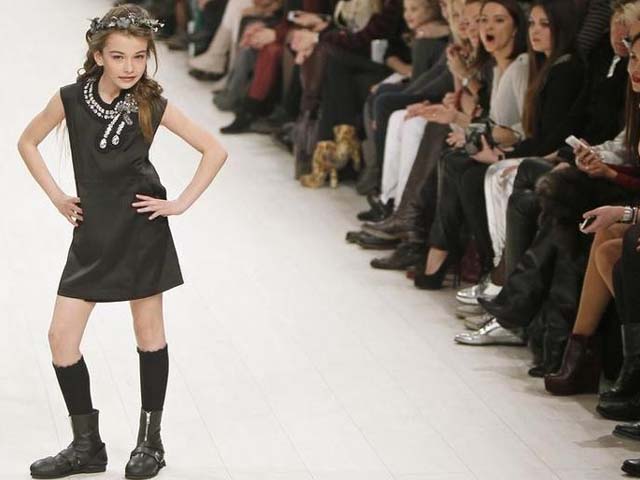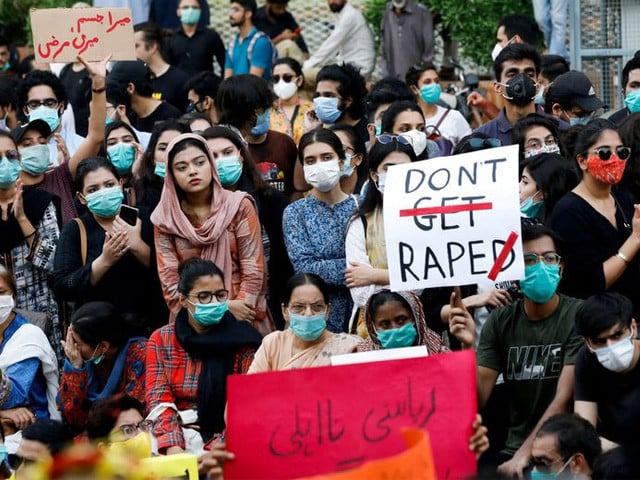
A model presents a creation by Ukrainian designer Viktor Anisimov during Ukrainian Fashion Week in Kiev. PHOTO: REUTERS
When models are seen and treated as professional hangers, and young impressionable girls want to be just like them
The constant cultural pressure to maintain a skinny and size zero body has made girls view their bodies as enemies.
The fashion industry is a confusing place. On one hand, it empowers women by employing them, giving them space in the public sphere and by creating an area ruled by women.
On the other hand, while it does all those wonderful things, it also puts women in the public eye (literally) in order to be judged and scrutinized.
In order for models to stay in the modelling business, they have to isolate themselves from their desires, especially if their desire is to have the food of their choice.
The obsession with being a size zero has spiralled out of control. Being slim and skinny has become a major concern for young girls and women around the world for a very long time now. This concern includes dieting, starving or skipping meals, counting calories within foods and exercising. What most women do not understand is that these concerns may have a negative effect, physically, emotionally and spiritually. As a result of this constant cultural pressure for a female to maintain a skinny body, girls tend to internalise these ideals and start to view their bodies as their very own enemies.
Diet plans and cosmetic surgery are not the only ways women try to achieve the perfect body; there are other life-threatening options which are taken up as a result of societal pressure, such as eating disorders. Women give into eating disorders such as anorexia and bulimia, thinking that it will help them look more acceptable. What they do not understand is that eating disorders harm their organs, cause depression and make binge eating and vomiting food a habit too hard to abandon.
One very positive example to counter these highly unattainable beauty standards is France’s new ban on extremely thin models. The French health minister said that this law has been brought in to tackle eating disorders as well as inaccessible levels of beauty. Not only that, it is a step to refrain young people from being exposed to normative and unrealistic images of bodies that leads to poor self-esteem and self-depreciation, which ultimately impacts health-related behaviour.
According to this law, models applying for jobs will have to provide a note from a doctor to prove they are not dangerously thin. This will be measured by their Body Mass index (BMI), which determines if someone is over or underweight based on their height and weight. The law basically prevents fashion houses from hiring models with a BMI of less than 18, which means a five feet-10 inches woman must weigh at least 125 pounds or 56 kilos.
Furthermore, from October 1st, photos of models that have been altered must be marked ‘photographie retouchée’ (retouched photograph). In addition, there are some hefty punishments as well. Employers who are found to be breaking the law could be fined €75,000 (£63,500) and jailed for up to six months.
Now, Harvard is asking other countries to follow suit.
Fashion models are essentially seen and treated as professional hangers. That is because tall and slim figures don’t hinder lines of clothing, especially if a designer has made a single, hand-worked avant garde garment for a runway show.
Moreover, the media itself plays an important role in repeating and reinforcing norms of society since it largely uses gender-based roles and stereotypes. The ideas about what is considered normal enough to pass as beautiful and powerful changes over time. For example, taking the late Marilyn Monroe into consideration, her voluptuous body was known to be sexy, attractive and beautiful throughout the 1960s and early 1970s.
However, in today’s world, that kind of body would most likely be considered unattractive and on the heavy/overweight side. Since women’s bodies are constantly a major victim of the male gaze, their bodies are looked at as sexual objects, and in a male-dominated world, only women without flesh are considered attractive.
Because fashion is a business, it is constantly finding new ways to attract consumers. It is about keeping consumerism alive and that’s exactly how it makes money. It’s a two-sided story and an issue of class as well. If consumers really cared about photoshopped images and skinny models on the catwalk, then they wouldn’t bother spending money on the items being advertised.
However, that hasn’t happened over the past years simply because the people who authentically care are only a small minority and are also not part of the target market for overpriced tags that stroke their egos.
There is something inherently wrong with obsessing over what women’s bodies should look like in order to sell products and in order for them to be considered feminine or attractive. There is also something very wrong with a culture that wants to see emaciated women not only in fashion or on screen, but in real life too.
Spain already bars models with a BMI below 18 from taking part in Madrid fashion shows whereas models on Italian runways must show health certificates to prove they are not underweight. Moreover, an advert for Yves Saint Lauren was banned by the Advertising Standards Authority (ASA) for featuring an ‘unhealthily underweight’ model. The ASA considered the model’s rib cage to be clearly visible and her thighs and knees appeared to be the same width. Hence, the advert was ruled as ‘irresponsible’.
 The Yves Saint Laurent ad banned by the advertising watchdog, which upheld a complaint that the model appeared to be too thin. It originally appeared in Elle magazine. Photo: ASA/PA
The Yves Saint Laurent ad banned by the advertising watchdog, which upheld a complaint that the model appeared to be too thin. It originally appeared in Elle magazine. Photo: ASA/PAAlthough France, after Italy, Spain and Israel, has taken the step to adopt this legislation, it is a matter of time before we find out how effective it is and to what extent punishments are given if the law is broken. It is essential to hold states accountable to make sure all citizens are growing up in a safe and healthy environment.




COMMENTS (2)
Comments are moderated and generally will be posted if they are on-topic and not abusive.
For more information, please see our Comments FAQ